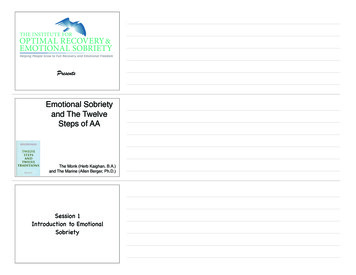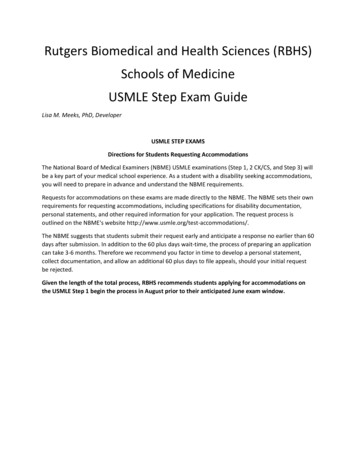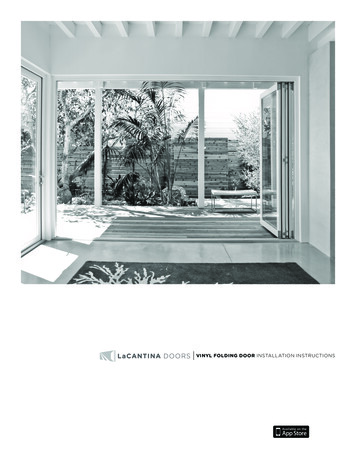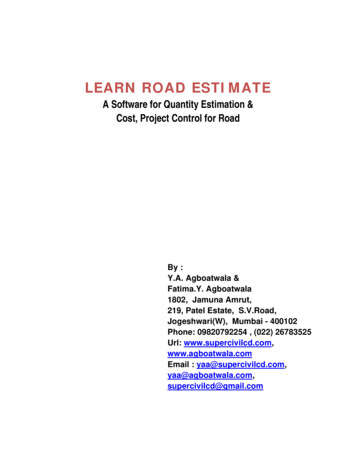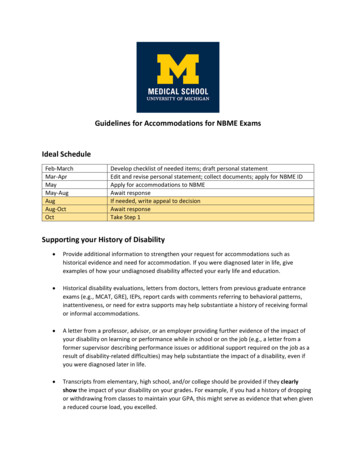
Transcription
Guidelines for Accommodations for NBME ExamsIdeal ctOctDevelop checklist of needed items; draft personal statementEdit and revise personal statement; collect documents; apply for NBME IDApply for accommodations to NBMEAwait responseIf needed, write appeal to decisionAwait responseTake Step 1Supporting your History of Disability Provide additional information to strengthen your request for accommodations such ashistorical evidence and need for accommodation. If you were diagnosed later in life, giveexamples of how your undiagnosed disability affected your early life and education. Historical disability evaluations, letters from doctors, letters from previous graduate entranceexams (e.g., MCAT, GRE), IEPs, report cards with comments referring to behavioral patterns,inattentiveness, or need for extra supports may help substantiate a history of receiving formalor informal accommodations. A letter from a professor, advisor, or an employer providing further evidence of the impact ofyour disability on learning or performance while in school or on the job (e.g., a letter from aformer supervisor describing performance issues or additional support required on the job as aresult of disability‐related difficulties) may help substantiate the impact of a disability, even ifyou were diagnosed later in life. Transcripts from elementary, high school, and/or college should be provided if they clearlyshow the impact of your disability on your grades. For example, if you had a history of droppingor withdrawing from classes to maintain your GPA, this might serve as evidence that when givena reduced course load, you excelled.
Letters from professors, teachers, guidance counselors or other people who can describe yourprevious academic performance may be helpful if they can show how your work was impactedby disability, or how the use of accommodations and strategies improved your performance. Ifyou were diagnosed later in life, if there was a professor or support person who suggested thatan initial evaluation might be necessary, or who first connected you with disability relatedsupports, a letter from that person might be helpful to contextualize your circumstances. Do not assume that because you received accommodations on previous exams, you are assuredaccommodations for the NBME. This is not a certainty. OMSE will work with you to identifyparticular gaps in your application and to ensure that you request only those accommodationsthat directly address the barriers that result from your disability (see: Types ofAccommodations).Alternatively, you might assume that because you have never received accommodations before,you will not receive accommodations now, leading to a decision not to apply. We cautionstudents against making this assumption and instead encourage you to reach out to the OMSEdisability services provider so that we can discuss your case. For those who have hadaccommodations in the past, while it is certainly possible that you will receive the sameaccommodations for the NBME exams, the NBME may decide that you are not eligible foradjustments based on their specific criteria ines.html) for eligibility. You may also find that the accommodationsoffered or approved are different from the ones you used in previous academic settings.The key to receiving accommodations on the USMLE Step 1, 2 or 3 exam is to build an “air tight”argument reflecting that: 1) You are a student with a disability, 2) Your disability acts as a barrierto the exam, 3) Accommodations will level the playing field, making the exam accessibleYou can find the guidelines for Documentation from the USMLE at: nes.htmlTypes of AccommodationsExtended time (standard time 25%, 50%, 75%, 100%)Extended time accommodations are more likely to be approved if the request is based onconcrete evidence from your documentation that support the disability‐related need for theaccommodation (e.g., very low academic fluency scores), and you have a history of receivingsuch accommodation. Your request should be based on the amount of time you have receivedhistorically, as this is what you know works for you.For example, you should not request 100% extended time if you have never been approved for100% extended time before. You should provide a clear rationale for all requests in yourapplication. You should consider the specific structure of the exam and the impact of extendedtime on taking the exam. For example, approval for 100% extended time (double time) may
necessitate that the exam be administered over two days given the length of the exam withstandard time. Depending on your disability, taking the exam over two days may be a barrier toyour performance; for example, this might increase anxiety in a student with obsessive‐compulsive disorder.Additional or extended rest breaksFor the USMLE, all test takers are given 45 minutes of break time for authorized breaks duringthe exam; however, you may request to have additional rest breaks added to the exam day asan accommodation. Instead of requesting an accommodation for multiple brief rest breaks, youwould request to have additional time added onto a standard break provided to all studentstaking the exam.From the NBME: BREAK TIME1Step 1, Step 2 CK, and Step 3Your test session is scheduled for a fixed amount of time and the computer keeps track of thetime allocated for each block and for breaks. At the start of the testing session, you have a totalof 45 minutes of break time for authorized breaks and for computer transitions between blocks.Authorized breaks include any time you spend between test blocks, whether you remain at yourseat or you leave the testing room. If you complete the tutorial or other testing blocks early, theremaining time will be added to your total break time. Once you begin a testing block, noauthorized breaks are provided during the block.If you take too much break time and exceedthe allocated or accumulated break time, the excess will be deducted from your total testingtime. Use the time summary feature (explained in the tutorial on test day) to keep track of yourtime. Step 2 CS Your Step 2 CS administration will include 12 patient encounters. Theexamination session lasts approximately eight hours. Examinees get a minimum of 45 minutes inbreak time, which includes a 30‐minute lunch period.If you have ADHD or another disability that benefits from the opportunity to take a brief breakto clear your head, this accommodation may be worth considering. On the USMLE exams, it maybe more appropriate than extended time as it gives you the opportunity to refocus yourthoughts versus extended time, which can lead to exhausting testing conditions.If you have health concerns that need monitoring, you may also wish to request additionalbreaks to check blood sugar levels, grab something to eat, or to take medications. (See also:personal item exemptions).You should request the specific amount of time needed for each break (e.g., a 10‐minute breakat the end of each exam section) as well as the frequency of breaks (e.g., after each section ofexam or every hour of exam time). If NBME approves this accommodation, they will tell you inadvance how the breaks will be structured so you are prepared on the day of the exam.
Multi‐day testingThis accommodation may be of significant benefit to someone whose cognition, physical abilityand energy level, or eyesight fatigues over a period of intense focus. Supporting documentationshould specify the amount of time a test taker can work on an exam per day.Testing in a Private EnvironmentIf you experience high levels of anxiety, distractibility, inattention, panic attacks, or similardisability related concerns you may wish to request this accommodation. If you require a privatespace for talking out loud or briefly stepping away from the computer to assist withcomprehension, focus, or managing anxiety you may find that a private environment isnecessary to allow you to use these key techniques to maximize your performance and tomanage your symptoms without disturbing others. It is important to decide whether breaksmight be helpful in order to use calming techniques in addition to, or in lieu of, thisaccommodation. If NBME approves this accommodation, it is important to remember thattesting centers have limited individual rooms. For that reason, you will need to secure a spacewell in advance, or may have to travel some distance to find a center with such provisions. Youshould investigate options for testing centers at the beginning of the scheduling process so youare fully aware of your options.Assistive software or technologyYou should consider requesting only the software or assistive technology that is absolutelynecessary to facilitate access to the specific exam format. Not all the assistive technology youuse in a normal course or in doing your course readings will prove useful on a specific exam.Your request should document your history of using such software, and specify why that specificsoftware is necessary for this exam, both due to the format of the exam (e.g., the format of theexam involves reading patient case examples, and thus includes a significant amounts ofreading) and due to the nature of your disability (e.g., you experience a significant amount ofeye fatigue, and thus need large print and reverse contrast screen colors; you are very familiarwith ZoomText software after 5 years of daily use, and should have access to the same softwareduring the exam due to familiarity with keyboard shortcuts, and settings). Your medical provideror evaluator should be sure to note their recommendation for the specific device, software ortechnology needed to facilitate equal access to the exam materials in the documentation.
For students who are deaf or hard of hearing (DHOH)From the NBME: DHOHThe USMLE computer‐based examinations (Step 1, Step 2 Clinical Knowledge, and Step 3) eachcontain a small number of multi‐media items, which may have an audio component. The Step 2Clinical Skills (CS) examination involves the use of simulated patients to test medical studentsand graduates on their ability to gather information from patients, perform physicalexaminations, and communicate their findings to patients and colleagues. The Step 2 CSexamination may involve one or more patient encounters where the examinee is asked tocommunicate with the patient by telephone. If you have a hearing impairment/hearing loss thatis covered under the ADA and that would impair your ability to access the examination contentunder standard conditions, please follow these Guidelines to request test accommodations.Comprehensive documentation of hearing impairments must include a report of a clinicalevaluation by a qualified professional (otolaryngologist and/or audiologist) and a copy of yourmost recent audiogram or audiometric report. The report of evaluation should include: Actual scores and results from all tests, procedures, measurements, and scales administeredfor the evaluation. Information about whether the hearing loss is static or changing. Hearing loss of a changingnature may need to be documented more frequently (e.g., within the past 6 months). Specific information concerning the current functional limitations imposed by the impairment(i.e., to what extent your day‐to‐day functioning is impaired by the hearing loss). Detailed information about what therapy and auditory aids are being used to treat theimpairment, and the effectiveness of these interventions, including any relevant post‐therapydata A specific recommendation for all accommodations requested, with an explanation of how theaccommodations will reduce the impact of the identified functional limitations on the specifictesting activity (this may be different for the CBT examinations vs. Step 2 CS). Your requestmust specify whether you require use of hearing aids, cochlear implants, or other assistivelistening devices for the day of your examination. Please provide specific information for anyassistive listening device, including hearing aids, such as the make and model number, and aphoto of the device for our review. Note that the photo should be of your own personal itemthat you are requesting to bring with you to the examination, not a generic photo of themake/model. At the conclusion of our review, you and your test center will be notified inwriting of the item(s) approved for your use during the examination. This approval is necessaryas unauthorized possession of personal items while in the secure area of the test center maylead to a finding of irregular behavior and permanent annotation of your USMLE transcript.Personal item exemptionsIf you need to bring anything into the exam that is related to your disability and considered“non‐standard” such as food, water or medication, a special cushion, hearing aids or cochlearimplants not Bluetooth or wireless enabled, and/or other medical devices, you will need tohave this approved in advance of the exam.
Some students are asked to send a photograph of their device as part of the approval process.These requests generally do not require the same “burden of proof” that other accommodationsrequire. Often the documentation requirement is a letter of support from a medical doctorstating the nature of the condition and the reason why the item is needed. We have reports ofstudents needing to declare items like leg braces, crutches, etc. A good rule of thumb is todeclare ANYTHING and allow the NBME to determine if such a declaration is not needed. TheNBME provides specific advice on this issue: mlNewly Diagnosed or No History of AccommodationsIf you do not have a history of accommodation or have been recently diagnosed with a disabilityYou must answer the question “why now?” The NBME will want to know why you havesuccessfully gained entry to medical school without accommodations, but now have difficultyaccessing the education curriculum. The examiner who diagnosed you will also be required tospeak to these issues.ApplicationAll individuals wishing to apply for accommodations on the USMLE exams will be required to fillout a detailed application and must include their USMLE number. A copy of the application isattached to this guide.Scheduling the ExamWhile under review you will NOT be able to schedule your exam. If you are approved foraccommodations you will receive a registration ticket within 5 days of the approval and onlythen can you register for the exam.Testing Centers and Accommodated TestingStudents should identify for themselves several testing centers for testing. Some will fill quickerthan others and when accommodated with assistive technology, extra‐time, or a private room,students may have limited choices.The Personal StatementFrom the USMLE: The Personal StatementD3. Personal Statement Attach a signed and dated personal statement describing yourimpairments(s) and their impact on daily life. Narratives should not be confined to standardizedtest performance. The personal statement is your opportunity to tell us how your physical ormental impairment(s) substantially limit your current functioning in a major life activity. In yourown words, discuss how your impairment(s) would interfere with your access to the relevantUSMLE Step and how the specific accommodation(s) you are requesting will alleviate this impact.The USMLE requires a personal statement as part of the accommodation request application.This is often the most time‐consuming part of the application process, but can be one of the
most important and compelling parts of the request. This is your only opportunity to share yourpersonal experience of living with a disability.This personal statement is unique and should focus on your areas of difficulty rather than yourstrengths. It is not the time to talk about how well you have been doing. Rather, you will need tohighlight what is difficult, what you do to manage it, and what remains a challenge. Weunderstand this may feel counterintuitive and can be emotionally difficult – we are here tosupport you. You can meet with OMSE staff to discuss your personal statement and ask forfeedback. While we do not provide extensive editing, we will work with you to help you bestarticulate your needs.Points of consideration for personal statements1. Explain the nature of your disability and why you are requesting accommodations. Include adescription of the day‐to‐day impact of your disability ‐ not just the impact on academictasks, like taking exams (e.g., impact on interpersonal relationships, employment, coursewithdrawals, personal organization, driving record, financial management, etc).2. Focus on your areas of difficulty rather than your strengths. This can feel awkward, becauseoftentimes students with disabilities are taught to put their “best foot forward” andemphasize their strengths when speaking about themselves. However, the personalstatement is not the time to talk about how well you have been doing. It is actually the placeto emphasize and highlight what has been difficult. It is essential that you connect youraccommodations to any successes. The burden to prove that the requestedaccommodations are necessary is on the student. Be very clear about the barriers posed bythe test, and the anticipated outcome if the accommodation you are requesting is not inplace. The barrier must be grounded in the nature of your condition, and substantiated bythe documentation you are providing.3. Pay close attention to the language you use to describe your needs. The cover letter shouldnot refer to a preference for an accommodation, but rather should emphasize your need forthe accommodation. Your job is to explain why the accommodations you are requesting arenecessary to ensure your access to the exam. For example, you should not say things like “Iwould do better with” or “to ensure my success,” as accommodations are designed to ensureaccess, not success. You should also avoid using phrases such as “learning differences,” asagencies are only interested in disabilities that require accommodations. It can be difficult tostart writing a personal statement.
General Checklist and Timeline for Accommodation Requests on the NBME ExamsSubmit all materials: (date)At least 10 months before you plan to take the exam:Find the information about the exam accommodation request processFind the deadline for making requests: Identify the appeal procedure and any associated timelines o Aim to make yourrequest at least 60 days in advance of their recommended deadline: Currently the USMLE is taking up to 120 days to respond to initial inquiriesMake a list of what historical documentation you need to gather: All historical evaluations Supplemental letters of support from previous instructors Letters documenting historical accommodation approval K‐12 § AP exams SAT/ACT exams Undergraduate Post‐bac program Graduate school Workplace Professional school MCAT accommodations Locate the documentation requirements for making your request Print a copy of the requirements Compare your most recent documentation to the requirements If your documentation doesn’t match, identify the specific reasons why andmake a list If you’ll need a new evaluation, begin contacting potential evaluatorsimmediately to determine the cost and how soon you can be evaluated. Evaluators likely will want to see your historical evaluations The new evaluator will benefit from knowing what the requirements arefor documentation; share the list of things you feel are missing from yourhistorical documentation A good evaluator will summarize your historical evaluations and explainany inconsistencies between them, and between any new results. Explain the deadline for submitting your applicationSchedule an appointment with your DS office to discuss your application Disability Services office might have copies of your historical evaluations or othermaterials you can include
Make a request for a letter of support and for The Certification of Prior TestAccommodations form Ask for tips and advice about your application, and inquire about other students’recent experiences. Inquire about any financial support towards re‐evaluation, and recommendedreferralsAt least 8 months before the exam, begin working on your personal statementTopic Prompts for Personal StatementsNote: Respond only to the prompts that are relevant to your circumstances. Explain the nature of your disability and why you are requesting accommodations.Describe how it affects you in medical school (reading, writing, studying, in classroom,lab, clinic)Include a description of the day‐to‐day impact of your disability (outside med school):interpersonal relationshipspersonal organization driving record financial management prior employment reading for pleasureExplain your history of using accommodations in all settings. K‐12 Undergraduate Other graduate programs Previous standardized testing (MCAT, SAT, AP exams, other) Employment Medical schoolWhat accommodations did you use?What additional challenges did you face in the environment?Were any accommodations provided informally that aren’t documented? What were they and why aren’t they able to be formally documented?If you do not have a long history of accommodations or have never utilized accommodationsin the past: Explain what is new now. Why are accommodations necessary at this time for thisexam?Is this exam different from others you have taken before? How?Is your diagnosis recent? If so, how did the diagnosis come about?What were the circumstances of your upbringing and/or early education that may helpthe evaluators to understand your late diagnosis/lack of accommodations?What challenges did you face in your life before you were diagnosed?
In education In your personal life What strategies did you use to succeed in school and your personal life in the absence offormal diagnosis, treatment, and accommodations? Is medical school different from your previous academic settings? How? How did you get by before you had accommodations? What strategies, services, supports, did you use? What were the challenges and successes associated? How are they insufficient for themedical school setting, and the USMLE exam in particular? Did you request but were denied accommodations on previous standardized exams (e.g.,MCAT)? If so, how did you ultimately succeed sufficiently to gain admittance in medical school,despite not having accommodations for this exam? What strategies and preparation were involved in your journey to medical school tobolster your application? Provide a rationale for each accommodation you are requesting What barrier does the exam pose, and how is it tied to your disability? If you have an example of a difference in performance with and without theaccommodation, provide this.Adapted from:Jain, N. & Bisagno, J. (April, 2016). Supporting Students Accommodation Requests on HighStakes Exams. 3rd Annual Disability in Health Science and Medicine Symposium. San Francisco,CA.ReferencesJain, N. & Bisagno, J. (April, 2016). Supporting Students Accommodation Requests on HighStakes Exams. 3rd Annual Disability in Health Science and Medicine Symposium. San Francisco,CA. Used with permission from Neera Jain to inform Appendix C.Jain, N., Lewis, C., Meeks, L.M., Tucker, T. (2015). The Process of Requesting Accommodationson Certification, Licensing, and Board Exams: Assisting Students Through the Application. In N.Jain & L. Meeks (Eds.), The Guide to Assisting Students with Disabilities: Equal Access in HealthScience and Professional Education New York, NY: Springer.USMLE Test Accommodations Website: http://www.usmle.org/test‐accommodations/
Writing the USMLE Personal StatementOverall Goal Prove you have a disability (per the ADA) that impacts your everyday lifeShow what the barrier is with accessing the examsState what you are requesting and why it will “ensure that the student’s performance is areflection of the understanding and mastery of the material tested, without reflecting thedisability”If your disability is developmental (LD, ADHD etc ) that you have had this present you whole life(documented or not)Guidance1. Explain the nature of disability and why you are requesting accommodations. Include a descriptionof the day‐to‐day impact of the disability—not just the impact on academic tasks such as takingexams (e.g., the impact on interpersonal relationships, employment, course withdrawals, personalorganization, driving record, financial management).2.Focus on areas of DIFFICULTY rather than strengths. Emphasize and highlight what has beendifficult. It is essential that you connect the requested accommodations to their successes. Be sureto state what the barrier is with accessing the exams.3. Emphasize the need for the accommodation rather than a preference. The barrier must begrounded in the nature of the condition, and substantiated by the documentation. State theaccommodation you are requesting and why it will “ensure that your performance is a reflection ofthe understanding and mastery of the material tested, without reflecting the disability.”4.Pay close attention to the language you use to describe your needs.Avoid these common word‐use pitfalls: “I would appreciate it if” . . . (do not ask for a favor; ask for legally mandated access) “It would be helpful to have” . . . (some might say it would be helpful for everyone) “I would do better with” or, “to ensure my success,” (you need to ensure access not success) “learning differences (“learning differences,” are not protected by ADA)
Use powerful phrases, as in these examples: “I require. . .As a result of [specify barrier],” “It is necessary that I am provided [specify accommodation].” “Throughout my education, [specify accommodation] has allowed me to demonstrate myunderstanding of materials on exams. I will require the same accommodation on this exam.”5. Discuss your history of disability.If the diagnosis is developmental (LD, ADHD, etc ) in nature, show that you have had this present yourwhole life. If you do not have official documentation showing a history: Establish1) why accommodations are necessary and2) why now? List effective self‐accommodation strategies used prior to an official diagnosis (e.g., reading textsover many times for comprehension, using extensive tutoring, utilizing a partner or study group tobreak down information, using reading or voice‐recognition software or having a friend or familymember read materials). List Informal accommodations. Describe what was provided in the past, how the provision cameabout (e.g., requested informally from professor, professor noticed that the student took longerto test and offered time), documenting this via a third party (the professor, a proctor, a dean ofstudents)If you have an acquired disability: (recent diagnosis that is not developmental in nature) you shouldprovide information about the onset of the condition and history of receiving accommodations sincethen, and explain any gaps or delays in using accommodations.Adapted from:The guide to assisting students with disabilities: equal access in health science and professionaleducation. Lisa Meeks-Neera Jain - Springer Publishing Company - 2016
The key to receiving accommodations on the USMLE Step 1, 2 or 3 exam is to build an "air tight" argument reflecting that: 1) You are a student with a disability, 2) Your disability acts as a barrier to the exam, 3) Accommodations will level the playing field, making the exam accessible







